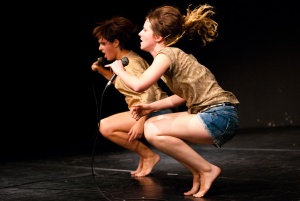In May 2011, the Slovenian artist Jasmina Križaj wrote the following article for a modul-dance newsletter regarding her experience in the framework of the project.
 Working period: from 04/04/2011 - 15/04/2011
Working period: from 04/04/2011 - 15/04/2011
Where: in Poznan, Poland - Art Stations Foundation
Who: Anja Bornsek, Cristina Planas Leitao, Jasmina Križaj and Tarras Some
Into the Out
Being in Poland was the first time for all of us. Have to admit I didn't know what to expect. There was a chance that it will feel like home and there is also very strong and in my opinion still somehow "fresh" historical memory. In some way it did feel like home.
After a long time I didn't feel like stranger while walking through the streets of another country.
We spend most of our time in the studio, which by the way, felt like a big privilege. It is a great theater/studio space, with beautiful made of red bricks back wall for great photos or video. The fact that the studio is in a shopping mall, gave us kind of perverse feeling. We are used to work far from so called normal human life, especially commercial one. But it is special when at and consumerism meet. I like the fact that somebody who doesn't reach so after art words but prefers commercial entertainment suddenly has both in one space. Maybe that changes people's perception about art. That it is not something just for privileged, that it is not something separated from our daily life, but it is actually like itself.
I was also giving technique classes of Flying Low. Have to say that I was very surprised by the speed and precision of working of Polish dancers. Really appreciate I could share my knowledge with them.
The work we did was very simple. But as they say "Less is more" was valuable also this time. The simplicity of the approach to the topic of Nervous System opened so many new chapters. Going deeper and deeper on physical, mental, philosophical and even emotional and spiritual level enrich and reveled many new possibilities but of course in the same time raised many new doubts and question. But I have to say those first two weeks of research were very productive and a good starting point and also a good take off for future research.
In the end I would just like to mention the generosity of the Art Stations Foundation team. Thank you very much!
Text written after an hour of shaking:
I feel like Leonardo DiCaprio in What's eating Gilbert Grape. With restless body. Swallowed back muscles like a puffy dove. Lying on the floor I feel the big mass of my heart. The weight of my heart. Its greatness and also whole its heaviness. I started fearing I could break the muscles/fibers that are attaching it to the sternum, if I continue shaking. I feared I would break my heart.
Wish to experience a slow motion fall. Maybe my legs don't shake, cause I believe that shaky legs represent weakness? So many tiny habits just in the fingers and those. Jazz took me. Then left me. Then allowed me to compose an e-mail. I sorted my mind. It eased my anger and have. Left leg and kidneys stayed as they are-exhausted, sucked, lonely, uncooperative.
Constant thought, every recognition has to be understood, constant trying to do, to try, to experience. Trying not to try. How are we spending our thoughts? Do we move because of discomfort, because of the pleasure that follows after releasing this discomfort?
Picture: © Saša Kuzjak

